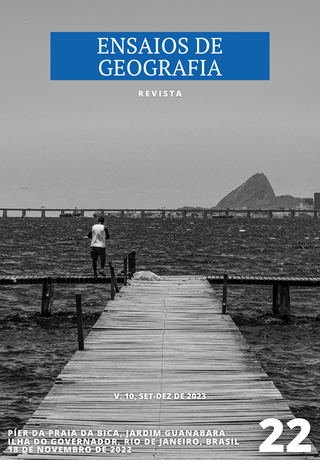LIVING SPACES OF A RIVERSIDE COMMUNITY IN PARÁ’S AMAZON FOREST
DOI:
https://doi.org/10.22409/eg.v10i22.57737Keywords:
Ribeirinhos, Lifestyle, Experiences, SpaceAbstract
This work is the result of a broader master's research that focuses on presenting the different dynamics experienced by residents of a riverside community in the Paraense Amazon, called Carapanatuba in the interior of the municipality of Santarém. The way of life and territorial dynamics of riverside populations are objects of study in various sciences, and here we are guided by geographic science, with the help of authors such as Santos (2002), Souza, (2018) and Tuan (2012) in the approaches of categories of space and place, which support the understanding of the living spaces of Carapanatuba residents. For the acquisition of information, field work was carried out, using interviews and other instruments such as cell phones, field notebooks, among others. Phenomenology was used as an analysis method, as it creates bridges so that we have access to the most accurate information and perceptions to hear, look, feel, perceive and evaluate all the phenomena that permeate the research. Through the observations and dialogues carried out during the work on the experiences of fishermen with their spaces/places of life, it is perceptible the affective relationship of fishermen with their home, which for them is seen as a “safe harbor”, with their boats, with the community, with the river. And that in the small daily practices in which knowledge about the dynamics of nature is socialized, is that they build symbolic and affective relationships with their places of life and work.
Downloads
References
ALMEIDA SILVA, A. Impactos Socioculturais em Populações Indígenas de Rondônia: Estudo da Nação Jupaú. (Dissertação de Mestrado em Geografia). Porto Velho: PPGG/NCT/UNIR, 2010.
BAUMAN, Z. Comunidade: A busca por segurança no mundo atual. Tradução, Plínio Dentzien- Rio de Janeiro: Zahar, 2003.
CRUZ, V. C. Itinerários teóricos sobre a relação entre território e identidade. In: BEZERRA, A. C. A.; GONÇALVES, C. U.; NASCIMENTO, F. R. do.; ARRAIS, T. A. (Orgs). Itinerários Geográficos. Niterói. EdUFF, 2007. p. 93-122;
DENZIN, N. K.; LINCOLN, Y. S. O Planejamento da Pesquisa Qualitativa: Teorias e abordagens. Porto Alegre: ARTMED, 2006.
FURTADO, L. G. Pesca artesanal: Um delineamento de sua história no Pará. Bol. Mus. Para. Emílio Goeldi, série Antrop., 1981.
FURTADO, L. G. 2002. Pesqueiros reais e pontos de pesca da territorialidade haliêutica ou pesqueira amazônica. Boletim do Museu Paraense Emílio Goeldi, v. 18, n. 1, jul., p. 3-26. Disponível em: <https://repositorio.museu-goeldi.br/bitstream/mgoeldi/788/1/B%20MPEG%20Ant%2018%281%29%202002%20Furtado.pdf>. Acesso em: 20 dez. 2023.
FURTADO, L. G. As origens pluriétnicas no cotidiano da pesca na Amazônia. Bol. Mus. Para. Emílio Goeldi. Ciências Humanas, Belém, v. 1, n. 2, p. 159-172, maio-ago. 2006. Disponível em: <https://doi.org/10.1590/S1981-81222006000200013>. Acesso em: 20 dez. 2023.
HALL, S. A identidade cultural na pós-modernidade. Rio de Janeiro: DP&A, 1997;
LOUREIRO, J. J. P. Cultura Amazônica: Uma poética do imaginário. Belém: Cejup, 1995;
LUTZ, M. S. A Imagem fotográfica como instrumento de pesquisa. 2010. Disponível em: <https://repositorio.ufsc.br/handle/123456789/120881>. Acesso em: 28 dez. 2022.
MARTINS, G, A; THEÓPHILO, C, R. Metodologia da Investigação científica para ciências aplicada. São Paulo: Atlas, 2009;
RUIZ, J. C. Geografia em Escala Local. Curitiba: SEED, 2008. Disponível em: <http://www.gestaoescolar.diaadia.pr.gov.br/arquivos/File/producoes_pde/artigo_joa o_carlos_ruiz.pdf>. Acesso em: Nov. 2022.
SANTOS, M. A Natureza do Espaço: Técnica e Tempo. Razão e Emoção. São Paulo, EDUSP, 2002.
SERPA, A. Por uma geografia dos espaços vividos: geografia e fenomenologia. São Paulo: Contexto, 2021.
SOUZA, M. L. Os conceitos fundamentais da pesquisa sócio- espacial. 4ª ed.- Rio de Janeiro: Bertrand Brasil, 2018;
SUERTEGARAY, D. M. Notas de epistemologia da Geografia. Florianópolis, 2005.
TUAN, Y. F. Espaço e lugar. A perspectiva da experiência. Londrina: Eduel, 2012; tradução de Lívia de Oliveira.
TRIVINOS, A. N. S. Introdução à pesquisa em ciências sociais: a pesquisa qualitativa em educação. São Paulo. 8a. Edição, Atlas, 2008.
VAZ FILHO, F. A. Dicionário Papa-Xibé do Baixo Amazonas. Santarém: Radio Rural de Santarém, 2010.
VAZ FILHO, F. A. A emergência étnica de povos indígenas no Baixo rio Tapajós, Amazônia. Tese (Doutorado em Ciências Sociais), Programa de Pós-Graduação em Ciências Sociais – PPGCS, Faculdade de Filosofia e Ciências Humanas – FFCH, Universidade Federal da Bahia – UFBA, Salvador, 2010.
WAGLEY, C. Uma comunidade amazônica: Estudo dos homens nos trópicos. São Paulo: Nacional, 1997.
Published
How to Cite
Issue
Section
License
Copyright (c) 2023 Da Revista (Ensaios de Geografia) e do Autor

This work is licensed under a Creative Commons Attribution 4.0 International License.
CC BY Attribution. Others may distribute, remix, transform, and build upon the material for any purpose, even commercially, provided they give the author and licensor the credits.


